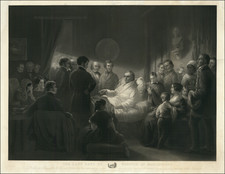"The Most Famous Image in the Early History of Computing."
Second edition (the first created in Lyon in 1839) of the most famous image in the early history of computing; the punchcard-loom-woven portrait of Joseph Marie Jacquard after a painting by Claude Bonnefond. The portrait shows the great innovator sitting in a chair (perhaps upholstered with Jacquard fabric?) holding a divider in his right hand to poke out holes in his punchcard - the first image of someone writing code?!
The city of Lyon commissioned Bonnefond to paint the Jacquard portrait in 1831 and later Lyon manufacturer Didier Petit et Cie commissioned this silk version which was produced by the specialist weaver Michel-Marie Carquillat using 24,000 punched cards. They were apparently produced to order beginning in 1839.
This second edition was produced in Zurich, Switzerland around 1847, also with the use of a Jacquard machine. The image was produced by Zurich-based Maschinenfabrik Rüti utilizing work by Fritz Kaeser.
Although similar mechanized looms had been used to create pattern images since the 18th century, this image of Jacquard represents a development in kind; the present image is an objective rendering of reality created by a machine-control binary system. It can thus be understood as a crucial antecedent to modern computer graphics.
Jacquard's Machine
Jacquard's machine was a mechanical loom that used a series of punchcards to determine the movement of thread controls such that the loom could be "programmed" to output an exact woven image, essentially automatically, over and over again. The genesis of his invention lies far back in the history of European organ making, but more recent advancements in the application of control systems to loom weaving had taken place in the 18th century. The series of relevant weaving inventions began with the Frenchman Basile Bouchon (1725) and continued with Jean Baptiste Falcon (1728), and Jacques Vaucanson (1740). Vaucanson's drawloom was evidently mothballed shortly after its creation, and it was not until over 50 years later, when Jacquard was asked to reassemble it in Paris, that his contribution began to take form. Whereas Vaucanson's machine relied on a drum to drive the control, Jacquard developed a linked-card system that could be endlessly expanded. This was a relatively incremental contribution, but it (and a change in the economic and manufacturing climate) meant that Jacquard's machines became far more prevalent and important than those that had preceded it.
Influence
Jacquard's machine failed to gain massive success in its home country of France, in part because fashion tastes had shifted away from gaudy, intricate patterns in the aftermath of the Revolution. They did, however, find great success outside of France, including in Britain. There they influenced a host of machine control systems, including giant steel riveters. However, perhaps the most important influence was on that of Charles Babbage, who used Jacquard punchcards in the design of his Analytical Engine. Ada Lovelace had pointed out: "We may say most aptly that the Analytical Engine weaves algebraical patterns just as the Jacquard-loom weaves flowers and leaves."









![[Jonah Negotiating His Embarkation] Quid demens latebras circumspicis alterum in orbem. Si fugirs Dominum, non tamen effugies. Cui tellus paret, summus cui militat aether, Non parere putas huic etiam Oceanum](https://storage.googleapis.com/raremaps/img/small/85070.jpg)
![(Native American Treaty Portrait Photograph) Wagasapa or Iron Whip, Ponca [Cabinet card photograph of WA-GA-SA-PI, Wagasapi]](https://storage.googleapis.com/raremaps/img/small/93033.jpg)
![[King George II] George de Tweede, Koning van Groot Britannie Frankryk, Ierland enz.](https://storage.googleapis.com/raremaps/img/small/83655.jpg)

![[First California Wine Making Image] The Vintage In California -- At Work At The Wine Presses](https://storage.googleapis.com/raremaps/img/small/89054.jpg)
![[Portrait] L'Amerique.](https://storage.googleapis.com/raremaps/img/small/79745.jpg)